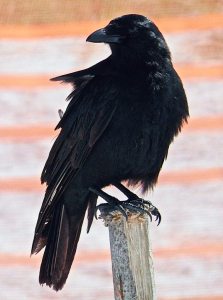
I like surprises. Recently, birding the beach has provided some that were subtle, some invigorating and one that was scary.
Fog
On the beach, fog is wet and cold, surprisingly so. My glasses, hair, face, even the hairs on my arms, have little droplets on them. Binoculars get slippery as does a water bottle.
I walk in essentially a 30-yard bubble where early morning shellers, heads down, look at the sand like gleaners. A lone great egret flies over the water, a messenger from another world. Ghost crabs, light colored and fast, disappear into their holes. How appropriate. A large group of mixed gulls and terns that congregate on the beach suddenly rise up and fly over the Gulf, a snowstorm of white wings and backs that settles back on the sand.
At the far end of the beach is a dead tree, on whose outstretched limbs are some brown forms. Over the years this tree has been a perch for ospreys and kestrels. This morning it is a perch for two pairs of mourning doves; one on the left side, the other on the right side. It’s hard to see them in a dark backdrop of palm trees. I have to get an angle against the milky sky to clearly see both pairs. The ones on the left have their heads facing in opposite directions; the pair on the right are both facing the sea. One of them calmly raises its head, looking into the mystery of fog. It is so absorbing to see their shapes, the color of their feet and their markings in this soup.
The lefties soon fly, perhaps because today is the Florida Presidential Primary and they want to vote for the Democratic Socialist Bernie. The righties remain, perhaps discussing a Stop Trump vote. They too soon quickly leave. When they do, the sides of the branches and trunk look like cream has been spilled all over them. Why didn’t I ever notice this before? The more you peer into the mysterious white stuff the more you discover.

(Photos by
Michael Givant)
Invigorating
After a few days of fog the early morning sky is one of pale blue and salmon, pale gray clouds and some wispy clouds. It’s cool and invigorating. A pair of mottled ducks is at the water’s edge. This is the time of year when they show up. The two don’t seem to be bothered by the proximity of people. A black-bellied plover whose belly has been white all winter now seems splattered with black. That’s summer plumage just beginning to show.
There’s a triangular wooden structure that was put up for a wedding a week ago that is starting to come apart. It’s currently being used by a number of fish crows that are perched on two posts, and a parallel bar. The scene resembles Hitchcock’s schoolyard scene in The Birds. Suddenly all but two rise up “cawing.” Large black shapes with splayed wings seem to stand still in the sky. Instantly, the last of the black forms are quickly in the distance backed by blue sky. The moment is so invigorating that the air feels fresher, the sky seems bluer.
The ticking biological clocks of two royal terns are telling them it’s mating time, even if the bulk of their peers won’t be doing so for a few weeks. The pair is taking a long time, suggesting to me that this is more practice than a real attempt. I closely watch his black feet trying to find firm footing on her white back while she moves gently like a seesaw. It’s a balancing act as he tries to steady himself by raising his wings high. As he moves to her rear he becomes highly active and then jumps off, wings raised. In two more weeks the beach will be filled with mating royal terns. This was just a preview.
Hammerhead
It’s a gray, mild morning. No gulls or terns out but there are numbers of shorebirds: sanderlings, ruddy turnstones, willets and one snowy plover. There’s a fishermen who is about to make my day. He’s patiently reeling in a catch. Partially out of the water, the body is silver, sleek, has a fin and a greenish line on the side. It’s a small shark and a wide flattened head comes into view. Chilling. It’s a baby hammerhead shark that is in excess of three-feet long. Its eyes are at the sides, which allow the creature to see 360-degrees above and below it at all times. Shark fin is an expensive delicacy in China.
Sometimes when hammerheads are commercially caught, the fin is removed, which is called ‘finning,” and they are thrown back alive, unable to swim, sink, and are eaten by other predators.
Carefully holding the rod with one hand and the tail with the other, the fisherman holds the thrashing shark away from his body. Carrying it to shore he puts it down and goes to a nylon bag, takes out a needle-nosed pliers and severs the hook. Now he holds the wildly thrashing creature whose small, nasty-looking mouth is beneath its face. Can it bend upwards and bite? He comes close to me but I have faith in this man’s skill and calm demeanor. He places the shark carefully in the water. At first the creature doesn’t move and the fisherman seems prepared to gently push it. However the shark turns parallel to the waves and disappears.
“He put up a good fight for his life, I’ll tell you that,” says the white-haired fisherman. I admire the skill, calm and concern shown by the man. I can only wonder what that shark saw from its 360-degree angle when it was out of water. If it has any memory at all, this will be an experience it doesn’t want to repeat.

































